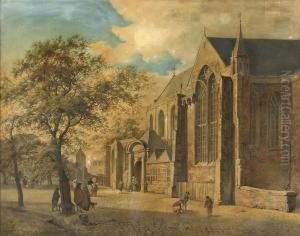Hendrick Van Cranenburgh Paintings
Hendrick van Cranenburgh was a Dutch artist born in 1744. He lived during a period of significant change in the Netherlands, which was marked by the Enlightenment and the early stages of the Industrial Revolution. Despite the lack of extensive documentation on his life compared to more prominent figures of his time, van Cranenburgh managed to carve out a niche for himself in the Dutch art scene through his distinctive style and contributions to the realm of painting.
Van Cranenburgh specialized in landscape and architectural paintings, capturing the serene beauty of the Dutch countryside as well as the grandeur of its cities' architecture. His works are characterized by meticulous attention to detail, a keen observation of light and shadow, and a profound appreciation for the natural landscape. These elements combined to create evocative compositions that resonated with the aesthetic sensibilities of his contemporaries.
Throughout his career, Hendrick van Cranenburgh exhibited a remarkable ability to adapt his style to the changing tastes of the art market while maintaining a consistent quality in his work. He was part of a generation of artists who were transitioning from the Baroque style, which was heavily ornamented and dramatic, to a more subdued and realistic approach that would later be recognized as part of the Romantic movement. This ability to evolve artistically allowed him to remain relevant in a rapidly changing art world.
His contributions, however, were not limited to his own artistic achievements. Van Cranenburgh was also involved in the Dutch art community, participating in exhibitions and engaging with other artists of his time. Through these interactions, he played a role in the development of the Dutch art scene, influencing younger artists and contributing to the collective advancement of Dutch art.
Hendrick van Cranenburgh passed away in 1832, leaving behind a legacy that, while perhaps not as widely recognized as some of his contemporaries, is cherished among art historians and collectors who appreciate the depth and beauty of his work. His paintings today offer a window into the Dutch landscape and urban environment of the late 18th and early 19th centuries, capturing a world that has since been transformed by the passage of time.
